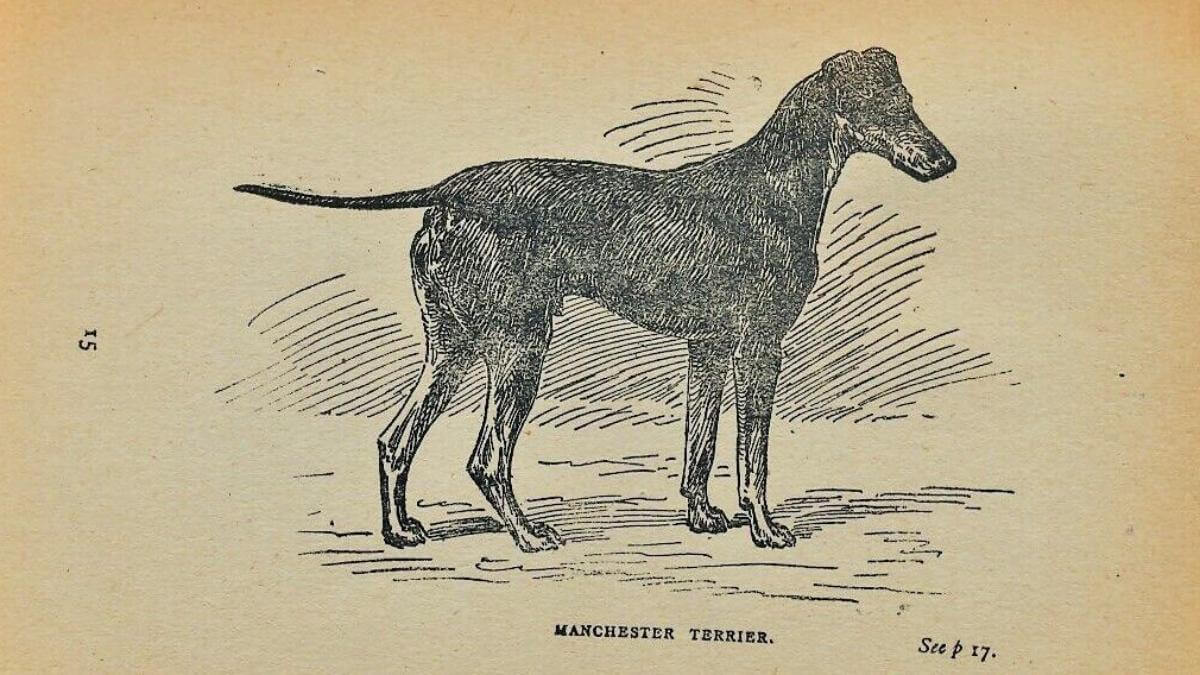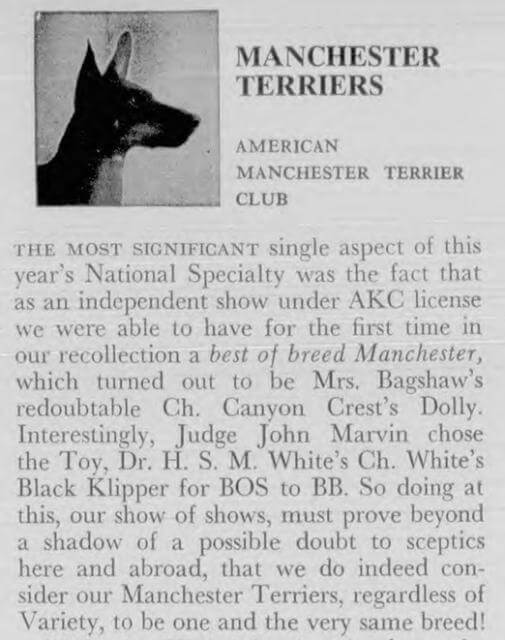
Home » One Breed, Two Varieties The Manchester Terrier Divide

Is it a coincidence that Shakespeare’s timeless tale about the Capulets and the Montagues hails from the same land and era as the ancestors of a breed whose fanciers have historically been at odds? Today, the American Kennel Club (AKC) recognizes the Manchester Terrier as one breed with two varieties, Toy and Standard, for which there is one parent club and one Breed Standard. It seems rather straightforward; however, just beneath the surface lies a tension that mirrors that other rivalry of British origin. Breed enthusiasts have long debated whether the two varieties are, or really should be, truly one breed. As recently as December 2023, the American Manchester Terrier Club (AMTC) waded into this tumultuous territory when it published a letter that the AKC Judges Education Department circulated to AKC Judges.

Breeders, judges, and exhibitors should understand that differences in size are a defining feature of the breed. While breeders may express preferences for one size variety over another, it’s important for judges to make placements consistent with the Breed Standard, which was written to reflect the breed’s history and the range of functions.
Before we dive into the fray, let’s lay some groundwork for how the breed is represented in the United States today:
Okay, phew! That’s a lot to digest! For our purposes, though, the important takeaway is this: The AKC views Manchester Terriers as one, single breed. Now that you understand the system, let’s get back to the essential question: Are they truly one breed?

Some fanciers today cite the unification of the two varieties as a recent development in the breed’s history. It’s true that, in the breed’s country of origin, the counterparts to the Toy and Standard varieties were split into separate breeds. (There will be more on that soon.) These fanciers believe that breeders who have favored one size variety over the other have, over time, created genetic siloes between them. They say the result has been such strong differences in type and temperament that they should be considered separate breeds.
Even among those who don’t advocate for splitting the varieties into two separate breeds, there is persistent debate over whether the varieties should be interbred, and whether dogs born from Toy parents should be shown in the Standard ring. Over the decades, many have been discouraged by their peers from exhibiting smaller Standards, especially if they have natural ears. Words like “oversized Toy” tend to get thrown around ringside and judges will frequently use the term when examining smaller Standard specimens, often without understanding the stigma that is attached to this term.
Two problems persist as a result of the belief that smaller dogs cannot be competitive in the Standard ring: Some breeders place specimens weighing between 12 pounds and 15 pounds in pet homes regardless of quality, effectively removing them from the gene pool of an already rare breed. Others have kept the 12- to 14-pound dogs in the Toy ring. While keeping these dogs in the gene pool is beneficial, it created a new problem: The actual Toys competing in the Toy ring look deceptively small if one is to assume all of the dogs in the Toy ring are the correct size.

With these conflicting views, one can understand why new people to the breed and aspiring judges pursuing mentoring opportunities may end up more confused than when they started.
The Manchester Terrier is often cited by breed historians as the closest living direct descendant of the Old English Terrier. This was a broad type of terrier originating in the United Kingdom for which written references can arguably be found as far back as the 1500s. These early dogs came in a variety of sizes, colors, and coat types, from which a number of today’s terrier breeds descend, including Welsh, Lakeland, Border, and Bull Terriers.
By the early 19th century, Manchester Terriers had become known for their varied talents and abilities, with a range of sizes to suit each purpose. Their role beside humankind included the utilitarian—rat catching, controlling vermin on farms, and coursing small game—and the long-outlawed bloodsport of rat baiting. In the rat pits, dogs were given a handicap based on their weight, with smaller dogs becoming prized for their advantage; they were matched against fewer rats. The black and tan “Tiny,” at 5-1/2 pounds, is the most famous rat killer in breed history, killing 200 rats in less than an hour.
In England, there was no mention of “varieties” in an official capacity when The Black and Tan Terrier Club was formed in 1884, just 10 years after the formation of The Kennel Club itself. The first Breed Standard described a breed that came in three sizes: “Toy (up to 7 lbs), Medium (up to 14 lbs) and Large (up to 22 lbs).” Notably, there was no distinction in the weight for dogs versus bitches in these ranges, something that holds true in the AKC Breed Standard today.

In 1885, just one year after the formation of the AKC, the first Black and Tan Terrier was recorded in the AKC Stud Book. In 1889, the AKC Gazette published the Breed Standard written by the Black and Tan Terrier Club in England, which became the US Standard as there was no organized AKC parent club representation for the breed at the time.
An excerpt from an 1885 Q&A column in the US magazine The Bazaar by Kennel Editor Hugh Dalziel answers a question about how large a reader’s Black and Tan Terrier puppy may grow. “We cannot tell you the size yours will grow to, as these dogs vary from a few pounds weight up to 30 lb.” Dalziel was author of several books about British dog breeds, and his reply provides further historical evidence of the range in size recognized in the Black and Tan Terrier.
In 1903, The Kennel Club in England began referring to the smaller specimens as Black and Tan Terriers (Miniature).
In the 1912 AKC Gazette it was announced that AKC had recognized the Manchester Terrier Club of America. By then, the AKC was referring to the smaller specimens as Toy Black and Tan Terriers and the larger as Manchester Terriers.
Just a few years later, the 1917 AKC Gazette published a ruling from the AKC Stud Book Committee declaring the Manchester Terrier and the Toy Black and Tan Terrier to be “distinct varieties of the same breed.” The committee further provided guidance on how to register dogs of inter-variety breeding, since the varieties were still registered separately at the time, though inter-breeding was permitted. Guidance was also provided on exhibition based on weight: “Any Manchester Terrier over one (1) year old of registered Manchester parents under 12 lbs in weight, may be shown as a Toy Black and Tan. Any Terrier having one parent Toy Black and Tan and one parent Manchester, must be shown as a Toy Terrier if under 12 lbs, and as a Manchester Terrier if over 12 pounds.”

That same year, breeder G. “Nellie” Campbell Schmidt shared the ruling in The Dog Fancier and offered this perspective: “…all breeders who are producing show stock use breeding stock weighing from three to 12 pounds, this statement can be verified by a close study of the parentage past and present, of show dogs; with few exceptions they trace to Manchester Terriers. My own little bitch, Champion Cambell’s May Bee, who won her championship under five pounds, was the grand-daughter of a fifteen pound bitch, being in the pedigree of almost every western winner for the past ten years.”
In England, following World War I, the larger size was nearly extinct, so perhaps that is why they were not officially renamed as the Manchester Terrier until the mid-1920s when their population was starting to rally. Despite the separation, the Miniatures and Manchester Terriers continued to have identical Breed Standards with the exception of weight and height. A 1931 breed profile that appeared in The Guardian by an author identified as J.B. stated, “From the large variety of Manchester Terriers the miniature one has been bred down, and except in the matter of size, he resembles his larger brother in every way.”
In a 1933 announcement from the AKC, they were officially renamed by the AKC Board to what we know them as today; the Standard Manchester Terrier and Toy Manchester Terrier. In that same announcement, the ability to inter-variety breed was reaffirmed.
Throughout the early 1900s, numerous articles in the media highlight the debate among fanciers about whether the two varieties should be separate breeds, and each time the AKC reaffirmed that the Toy had always been and will continue to be “a diminutive version of the Standard” (terminology that remains in the AKC Breed Standard today).
In the late 1800s and early 1900s, it became fashionable in some circles to breed the Toy variety as small as possible. The result was specimens as small as two and three pounds, with a resulting loss of vigor and breed type. Perhaps due to the poor condition of the Toy variety, or because the country of origin had already split the varieties into separate breeds, in 1937, The Manchester Terrier Club requested that AKC discontinue the practice of registering inter-variety breedings. It should be noted that the Toy Manchester Terrier at the time was without organized representation, as the parent club was not formed until 1938. The AKC refused to change its policy regarding inter-variety breeding and, in their response, wrote:
“The committee feel that cross-breeding of the two can produce only Manchester Terriers and that, therefore, they are entitled to certification by the American Kennel Club as pure-bred. They cannot be considered mongrels. Breeders of Toy[s] have found it necessary and desirable from time to time to introduce the blood of the Standard size dogs into their strains. Breeders of the Standard size need not breed their dogs to Miniatures unless they wish to. The Manchester Terrier Club which functions for the Standard size Manchester and is not interested in the Toy Manchester, may, if it wishes, endeavor to discourage the cross-breeding by pleading its members not to breed their dogs to Toys, but there seems no reason for the American Kennel Club to refuse the result of such cross-breeding registration in the Stud Book.”
World War II resulted in another near extinction for the Manchester Terrier in Europe, and The Kennel Club in England once again permitted inter-breeding with the Miniatures into the 1950s.
Around this same time, The Kennel Club in England recognized revised Breed Standards. It renamed the Miniatures to English Toy Terriers (Black and Tan) as they are known today, particularly in the UK and Europe. While inter-breeding was eventually disallowed in the UK, this restriction of the gene pools has been circumvented by importing dogs from North America where inter-variety breeding has been continuously allowed.

In the US, where the Standard Manchester never really enjoyed high numbers, the larger variety had declined to the point where the parent club had dissolved. To that end, the varieties were formally recombined and placed under the umbrella of one breed club in 1959. Prior to the American Toy Manchester Terrier Club’s (ATMTC) 1958 annual meeting, for which the members were due to vote on whether to combine the breed clubs, a persuasive letter was penned by the ATMTC leadership and sent to the membership. It stated, in part:
“This feature is we believe invaluable to Toy Man. Breeders. It will give more latitude in improving the Toy by protecting the usefulness of good dogs who are three or four pounds too big… The problem of oversized Toys has long plagued our Club and its breeders. That problem has long been discussed at our annual and other meetings. This is a grand opportunity to settle this matter once and for all.”
It’s important to recognize that the restriction on exhibiting “oversized Toys” was self-imposed among American breeders. The term “oversized Toys” is, in fact, a misnomer, though still heard around the ring and in breed circles today. The Breed Standard clearly states that once a dog exceeds 12 pounds, it must be exhibited in the Standard variety. And while the recombination of the varieties did take some persuading, the vote did pass. The resulting increase of inter-variety breeding successfully restored breed type and genetic diversity in the breed as a whole.
Just a few years later, in the June 1963 breed column published in the AKC Gazette and penned by Mrs. John P. Knox, Jr., the newly named American Manchester Terrier Club celebrated the first awarding of Best of Breed for the Manchester Terrier in AKC history. The author highlighted that a Standard was awarded BOB and a Toy was awarded Best of Opposite Sex, and concluded that, “doing [so] at this show, our show of shows, must prove beyond a shadow of a possible doubt to sceptics here and abroad, that we do indeed consider our Manchester Terriers, regardless of Variety, to be one and the very same breed!”
The 1959 combining of varieties is often cited by breed fanciers today as the point at which the Toy and Standard debate began, but as the club correspondence shows, club leadership had hoped it would put this debate to rest. If only!
Finally, our historical trek concludes with the aforementioned letter distributed by the AMTC in December 2023. Directed to AKC Judges approved to judge the breed, the letter, among other things, pleaded with judges to weigh larger exhibits to ensure they were not over the maximum weight as defined for each variety, and providing all exhibits were within the allowable range (12 pounds and Under for Toys, Over 12 and not exceeding 22 for Standards) giving equal consideration to all exhibits regardless of weight. That letter states:
“With regards to size, our standard states that ‘The Toy variety shall not exceed 12 pounds,’ and ‘The Standard variety shall be over 12 pounds and not exceeding 22 lbs.’ Please note, there is no preference for size described within the weight limit. Historically, the breed was regarded for its versatility, which is partly due to the range of size found within the varieties. Judges should not disregard smaller specimens in either variety based on size alone.” [emphasis in original]
We have now examined numerous primary sources demonstrating that, historically, the two varieties have been treated as one, both in breeding and exhibition—and its staunchest supporters have been arguing about it for the entire time as well!
Today’s breeders seem to fall into two camps; those who believe it is a cardinal sin to inter-variety breed, affecting the purity of their favored variety, and those who believe inter-variety breeding is beneficial to the genetic diversity and conformation of the breed as a whole.
The AKC’s position has been consistent for more than 100 years, and the AMTC has been steadfast since its founding. The AKC Breed Standard, describing both sizes of Manchester Terrier, has been almost identical since it was first written down more than 140 years ago. As shown in the accompanying artwork, breed type, regardless of size, remained consistent 150 years ago. It is long past time to put the argument to rest.
It is important for judges, breeders, and exhibitors to remember that differences in size are a defining feature of the breed, not a flaw. Similarly, there’s nothing wrong with breeders having a preference for one size variety over another, as long as those preferences don’t come at the expense of the breed. It is vital that we educate new fanciers and aspiring judges in a way that is accurate, consistent, and derived from historical facts. The continuation of what is arguably one of the oldest terrier breeds depends on our ability to be unified in protecting its best interests and safeguarding it for future generations to discover.
The full letter published by the American Manchester Terrier Club in December 2023 appears elsewhere in this issue and may also be found on the AKC Conformation Judges Blog:
https://akcconformationjudges.wordpress.com/2023/12/27/judging-the-manchester-terrier/
Special thanks to fellow Manchester Terrier fancier Amanda Kelly for her invaluable work in scanning, organizing, and helping to interpret the historical reference materials that supported this article.
